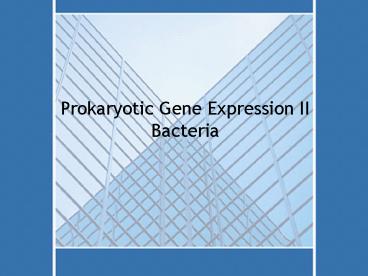Prokaryotic Gene Expression II Bacteria PowerPoint PPT Presentation
1 / 24
Title: Prokaryotic Gene Expression II Bacteria
1
Prokaryotic Gene Expression IIBacteria
2
Overall outline
- Introduction to Bacteria
- Genetic Recombination in Bacteria
- Regulation of Transcription
3
Introduction to Bacteria
- Bacterial structure
- Bacterial life cycle
- E. coli DNA
- E. Coli dividing binary fission
- Plasmids
- Replication of the bacterial chromosome
4
Bacterial structure
- Prokaryotes are distinguished by having no
membrane-bound organelles. - The DNA genome is gathered in a central region
called the nucleoid. - Bacteria are also uniquely characterized by a
rigid cell wall which serves to resist osmotic
stress. - Bacteria can be classified in terms of their
cell-wall components and in terms of their shape.
5
Bacterial life cycle
- Bacterial growth (generally exponential) usually
involves asexual reproduction (binary fission)
sexual reproduction via gene transfer is rarer. - The resulting semi-log growth curve involves
lag, logarithmic and stationary phases.
6
E. coli DNA
7
E. Coli dividing binary fission
8
Plasmids
9
Replication of the bacterial chromosome
10
Genetic Recombination in Bacteria
- Detecting genetic recombination in bacteria
- Transduction
- Conjugation Bacterial mating
- Recombination in E. coli
- Insertion sequences, the simplest transposons
- Insertion of a transposon and creation of direct
repeats - Anatomy of a composite transposon
11
Detecting genetic recombination in bacteria
12
Transduction
(during lysogeny)
(during lysis)
13
Conjugation Bacterial mating
14
Recombination in E. coli
15
Recombination in E. coli
16
Insertion sequences, the simplest transposons
17
Insertion of a transposon and creation of direct
repeats
18
Anatomy of a composite transposon
19
Regulation of Transcription
- Regulation of a metabolic pathway
- The lac operon regulated synthesis of inducible
enzymes - cAMP
- Positive control cAMP receptor protein
- The trp operon regulated synthesis of
repressible enzymes
20
Regulation of a metabolic pathway
21
The lac operon regulated synthesis of inducible
enzymes
- Regulation of gene expression often occurs at
the level of transcription. - The most common strategy is to control the
binding of RNA polymerase to the promoter or to
block its precessive activity along the operon. - Eukaryotic regulatory mechanisms are more
complicated and involve a variety of DNA enhancer
elements and protein transcription factors. - The lac operon depicted here is a prototypical
system.
22
cAMP
23
Positive control cAMP receptor protein
24
The trp operon regulated synthesis of
repressible enzymes

